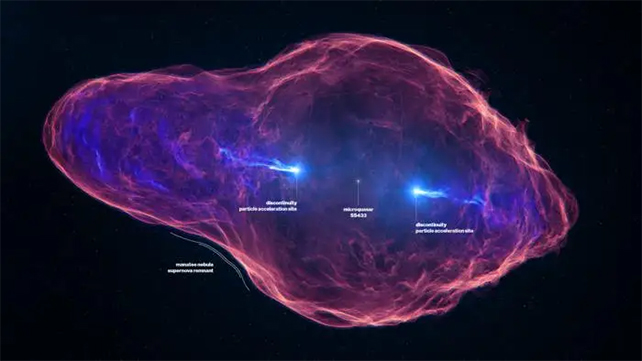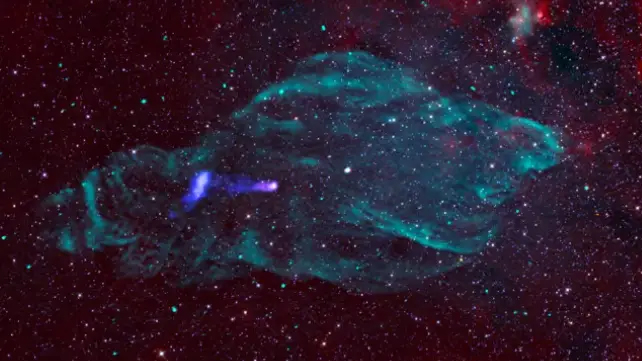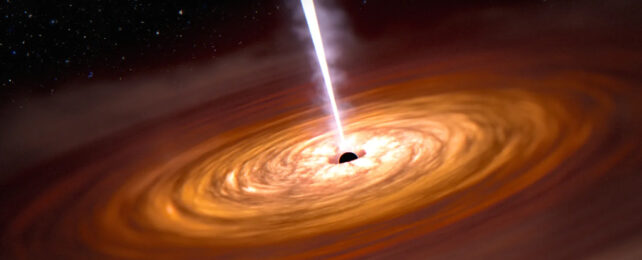A small black hole is helping scientists understand how mysterious cosmic rays can barrel through the Universe and hit Earth at nearly the speed of light.
High-energy cosmic rays are constantly raining down on us from space, but scientists don't know that much about them. One long-standing mystery is how cosmic rays can reach our planet at such speeds.
For the first time, researchers looking at the black hole have spotted a naturally occurring particle accelerator that is speeding up the cosmic rays bombarding our planet.
"Over the past years, we could say: 'yes, there is particle acceleration. How? impossible to tell. But there is'," Laura Olivera-Nieto, an author on the paper and a researcher from the Max-Planck-Institut für Kernphysik in Heidelberg, told Business Insider.
"Now we're entering an era where we can actually answer where and how," she said.

Speedy cosmic rays come from black holes and exploding stars
Our planet is swimming in a sea of cosmic rays. These charged particles bounce around the Universe, bringing with them a lot of energy.
If these rays were to strike our planet unfiltered, life on Earth wouldn't be possible. Cosmic rays travel at nearly the speed of light – that's so quick that they can pass through our bodies like air, bringing so much energy that our DNA would be shredded into ribbons.
Thankfully for us, our planet's atmosphere protects us from the worst of the radiation. But it's still important for us to understand how it appears in our Universe, especially as more countries invest in making humans a multi-planetary species in the future.
And one of the things we really don't understand is how they reach the speed they do.
Peering at the heart of a jet
When scientists look at cosmic rays coming from quasars and supernova, usually all they see is a big blob.
High-energy cosmic rays come from quasars that are very far away – any closer and they'd blow up the Milky Way, so they are difficult to see in detail. Supernovae can be closer nearby, but they send low-energy rays, that are really faint when seen from a telescope on Earth.
But a nearby cosmic object called SS 433 provided a rare opportunity to peer into cosmic rays in unprecedented detail.
SS 433 is a microquasar, meaning it's a small black hole about ten times the mass of the Sun. It's located in the Manatee nebula, a cloud of gas left behind by a burst star about 18,000 light years.
"It's called a microquasar because it's like a miniature version of these things," said Olivera-Nieto.
That means it is weak enough to be close by but strong enough to spew out higher energy particles than a supernova.
There's another reason why this microquasar is so "special" said Olivera-Nieto said. These objects usually have jets that last for a day or two.
"This one has had jets for 50 years, which is extraordinary because it's the only one that we know that has kind of gotten stuck in a state," she said.
When Olivera-Nieto and colleagues looked at this object, they found that there was a big gap in the jets. They could see small spirals around the black hole, about 0.1 parsecs away, then nothing, and the jets re-appeared about 75 light-years further.
Scientists think that the gap is where the particles are being accelerated to near the speed of light.
The location of the accelerator tells us how it works
Scientists have three theories to explain how this natural particle accelerator works.
One is that magnetic field lines around the black hole carry these particles, and they come under so much tension that they violently snap, propelling the particles into space.
But in that case, the accelerator would be quite close to the black hole.
Another is that the black hole creates tunnels that boost the particles as they bounce off the sides. But then the particles would get gradually quicker.
The observation, for the first time, favors a third hypothesis: the particles run into an invisible wall, a so-called discontinuity, that abruptly stops the particles in their path.
That change in speed causes energy to build up around the particles, giving them that speed when they eventually break through.
The question now is: what creates that shock?
"We don't know because it's quite intriguing because it's happening on both sides symmetrically," said Olivera-Nieto.

"So this means that it's somehow connected to the system itself," she said.
The findings were published in the peer-reviewed journal Science.
This article was originally published by Business Insider.
More from Business Insider: